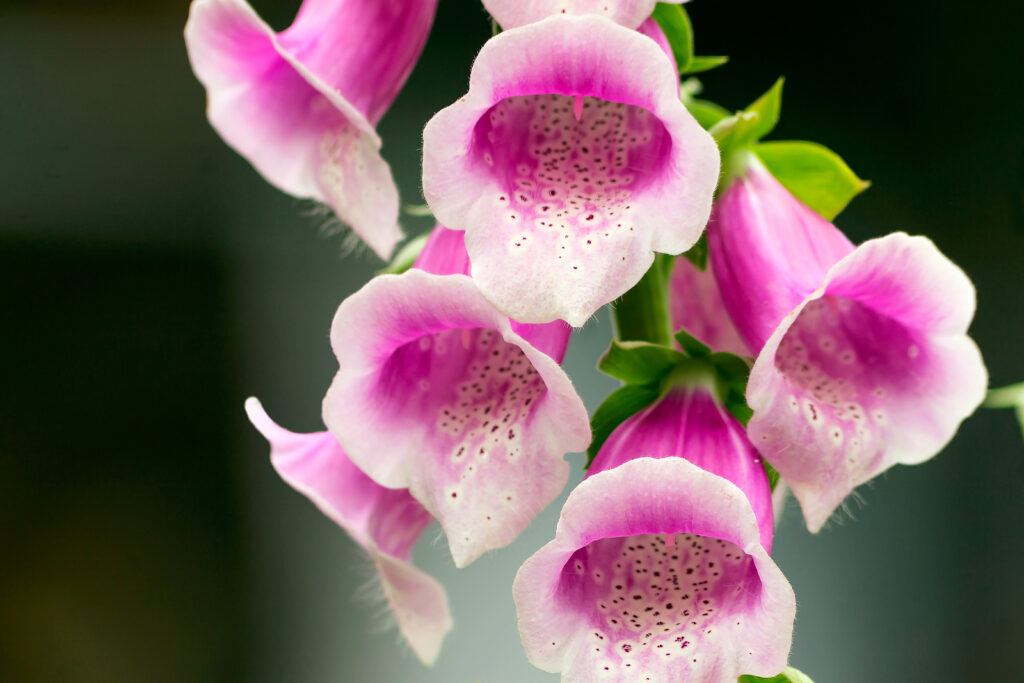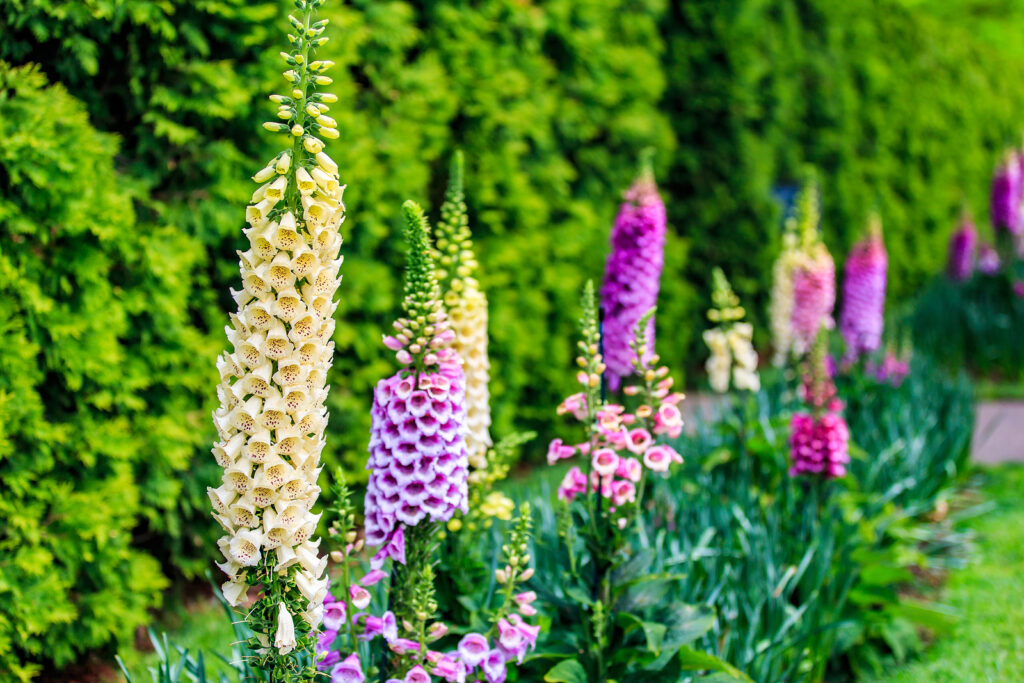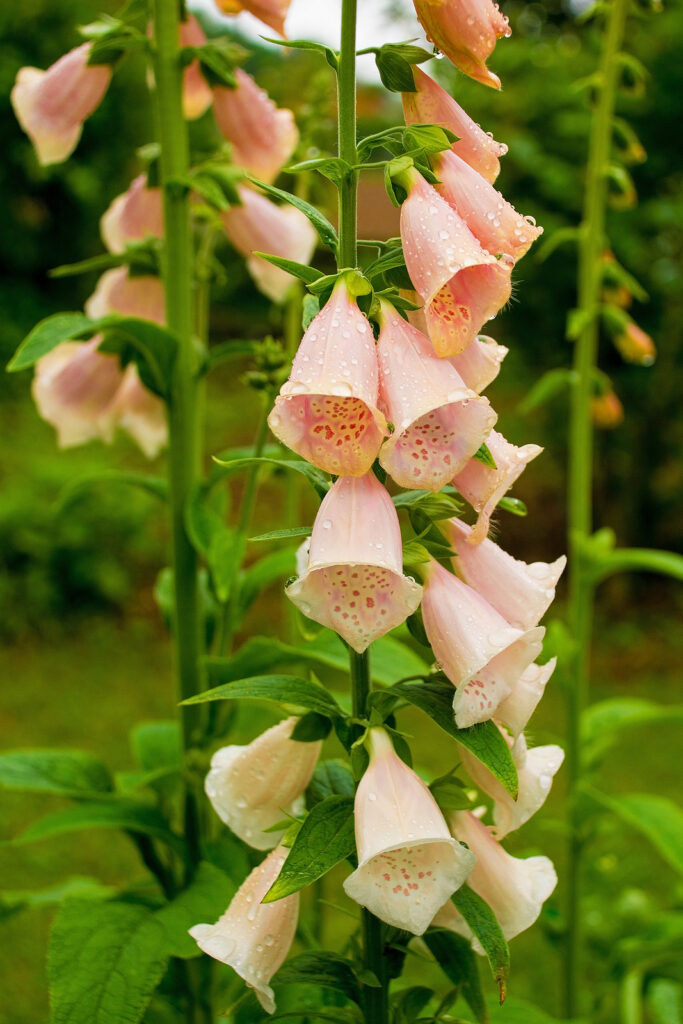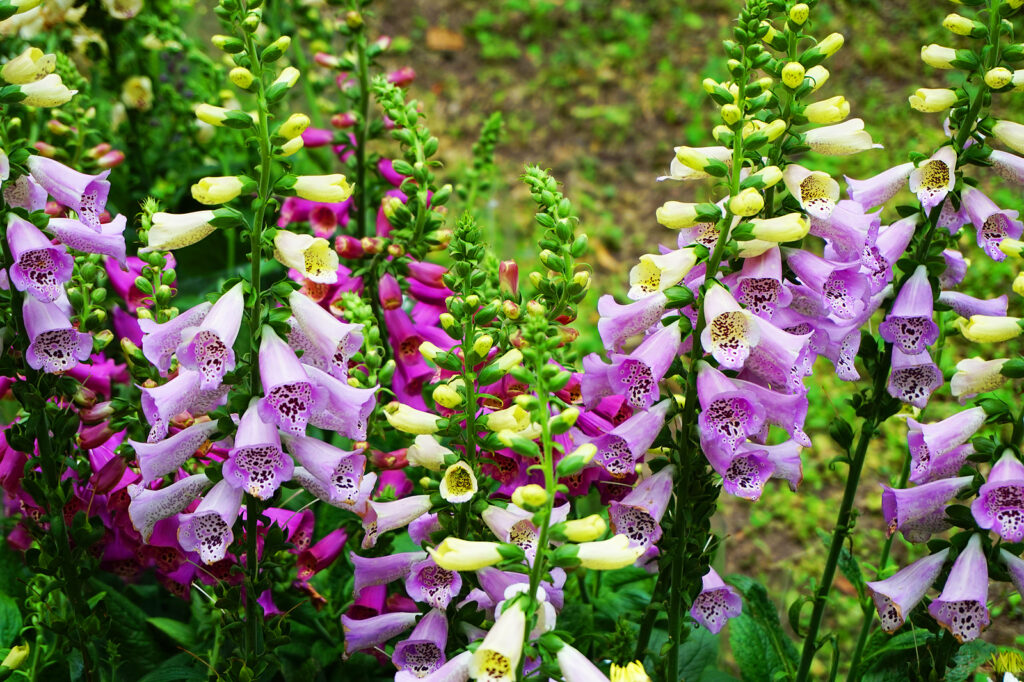Digitalis-commonly called foxglove–produces tall graceful spires of long, slender, bell-shaped blossoms. The blossoms open from bottom to top over several weeks. Flowers come in shades of pink, as well as white and creamy yellow.
Digitalis are members of a genus of about 22 species of biennials and short-lived perennials. Common foxglove, D. purpurea, is an often-planted, old-fashioned garden favorite. Flowers in this genus are borne on erect spikes; flowers are tubular or funnel-shaped. Flower spikes rise above a rosette of large, lance-shaped leaves.
Good Products for Seed Starting Success at Amazon:
- Jump Start Germination Station w/Heat Mat Tray, 72-Cell Pack, Dome
- Espoma Seed Starting Mix
- 200 Count- Jiffy 7 Peat Soil Seed Starting Plugs
- Seed Starter Kit with Humidity Dome (120 Cells Total Tray)
- AgrobriteT5 Fluorescent, 2-Foot, Grow Light System
Plant Digitalis in groups in dappled shade. Use foxglove in borders, cottage gardens, woodland gardens, and rock gardens. Digitalis grows well with ferns and looks right in place on slopes. Digitalis are cold hardy, but heat sensitive. They grow best when summers are not too hot.
Important note: All parts of the foxglove are toxic. If ingested contact a local poison control center.

Get to know Digitalis — foxglove
- Plant type: Biennial or perennial; it can be grown as an annual, biennial, or perennial depending on variety and climate.
- Growing Zones and range: Zones 4 to 8; grow as a biennial in Zone 9.
- Hardiness: Hardy to -30°F (-34°C); cold hardy but heat-sensitive; grows best where summers are not too hot.
- Height and width: 2 to 5 feet (.6-1.5m) tall; 12 to 24 inches (30-61cm) wide
- Foliage: Bold, oblong to lance-shaped, gray-green, hairy leaves
- Flowers: spikes of bell-shaped flowers; shades of rose, pink, white, and yellow; plants bloom the second year; readily reseeds
- Bloom time: Late spring or early summer
- Uses: Add to informal or cottage garden; a good choice for a woodland garden or rock garden
- Common name: Foxglove
- Botanical name: Digitalis purpurea
- Family: Scropulariaceae
- Origin: Europe, Northwestern Africa to Central Asia
Where to plant Digitalis — foxglove
- Plant Digitalis in full sun in Zones 4-7; plant foxglove in partial shade in Zones 8-9.
- Grow Digitalis in humus-rich, well-drained soil.
- Digitalis prefers a soil pH of about 6.5.
Digitalis uses and companions
- Mass Digitalis for a lovely vertical effect in borders and in cottage and shade gardens.
- Good garden companions for Digitalis include Alchemilla mollis, Campanula, Dicentra, Hosta, Thalictrum.

When to plant Digitalis — foxglove
- Set established Digitalis seedlings outdoors in spring.
- Biennial types can be seeded in the garden in midsummer.
- In Zones 7-9 established seedlings and be set in the garden in the fall for bloom the following spring.
- Start seed indoors any time from late winter to the end of spring in temperatures near 60°F (15.6°C).
- Sow seed outdoors in spring after the last frost or in summer in northern cool-summer regions; in mild-winter regions, sow seed in autumn.
Planting and spacing Digitalis — foxglove
- Sow seed indoors in six-packs or flat filled with a moist, sterile seed-starting medium; do not cover the tiny seeds because they need light to germinate.
- Sow seed 1/8 to 1/4 inch deep.
- Space seeds about an inch (2.5cm) apart,
- Seeds should germinate in 14 to 21 days.
- Thin or transplant seedlings when they are 3 to 4 inches (7.6-10cm) tall; transplant seedlings to individual pots.
- Transplant seedlings outdoors when they are 8 inches (20cm) tall or more. Set plants outdoors after hardening them off for several days.
- Space Digitalis 1 to 2 feet (30-61cm) apart.
- Plant Digitalis in groups of 10 or more for the best effect.
How to water and feed Digitalis — foxglove
- Keep the soil evenly moist; some varieties tolerate less water.
- Add aged compost to the planting bed ahead of planting.
- Fertilize Digitalis lightly at planting time; feed plants every four weeks with an all-purpose liquid fertilizer.

Digitalis — foxglove care
- Mulch around foxglove to keep the soil evenly moist.
- Stake tall plants to keep them from flopping over, especially in windy areas.
- Remove flowering stems after they bloom unless you plan to harvest the seed; trim back the tops after they turn brown in autumn.
- Protect plants with 2 inches (5cm) of chopped leaves or light mulch in winter.
Digitalis — foxglove pests and diseases
- Pests and diseases include mildew, leaf spot, and Japanese battles. Control beetles with pheromone traps.

Digitalis — foxglove propagation
- Sow seed from spring until late summer either in a frame or in the open garden.
- Digitalis seed germinates in 20 to 30 days at 60° to 70°F (16°-21°C).
- Divide large clumps with multiple basal rosettes when new leaf growth begins in early spring. Do not cut rosettes in half, just separate them.
- Replant division immediately; they should bloom the same year.
Digitalis — foxglove varieties to grow
- Digitalis grandiflora: Biennial or perennial that grows to 3 feet tall with racemes of 2-inch long pale yellow tubular flower.
- D. lutea: Biennial or perennial that bears racemes of pale yellow or white flowers.
- D. x mertonensis, strawberry foxglove: Perrenail grows 5 to 7 feet tall and has coppery rose flowers in late spring or early summer; seeds grow true.
- D. purpurea, common foxglove: Biennial or short-lived perennial grows 2 to 6 feet tall; bears showy spikes of 2 to 3-inch flowers in rose-purple, white, pink, or creamy yellow; blooms are commonly spotted with purple inside; is used by plant breeders to develop many cultivars widely available.‘Excelsior’ hybrids bloom the first year from seed.
Foxglove frequently asked questions
Q: Can I start foxglove indoors?
A: Yes. for an early start, sow seeds of foxglove 8 to 10 weeks before transplanting outdoors. You can set seedlings in the garden 2 to 3 weeks before the last spring frost.
Q: How do I start foxglove outdoors?
A: Foxgloves are easy to grow from seed. Simply scatter seeds on the ground after the last spring frost. You can also start them in a cold frame in late fall and transplant them to the garden in summer.
Q: What growing conditions do foxglove prefer?
A; Foxglove likes humus-rich, well-drained soil that is slightly acidic. Grow foxglove in full sun in slightly moist soil.
Q: Can I get foxglove to bloom twice in a season?
A: Yes. Cut the main flower stem after it finishes blooming and other flowers will grow, Leave a few dead flowers on the plants to get them to self-sow and naturalize.
Q: Should I fertilize foxglove during the growing season?
A: Yes. To get better blooms, feed foxglove a liquid fertilizer during flowering.















